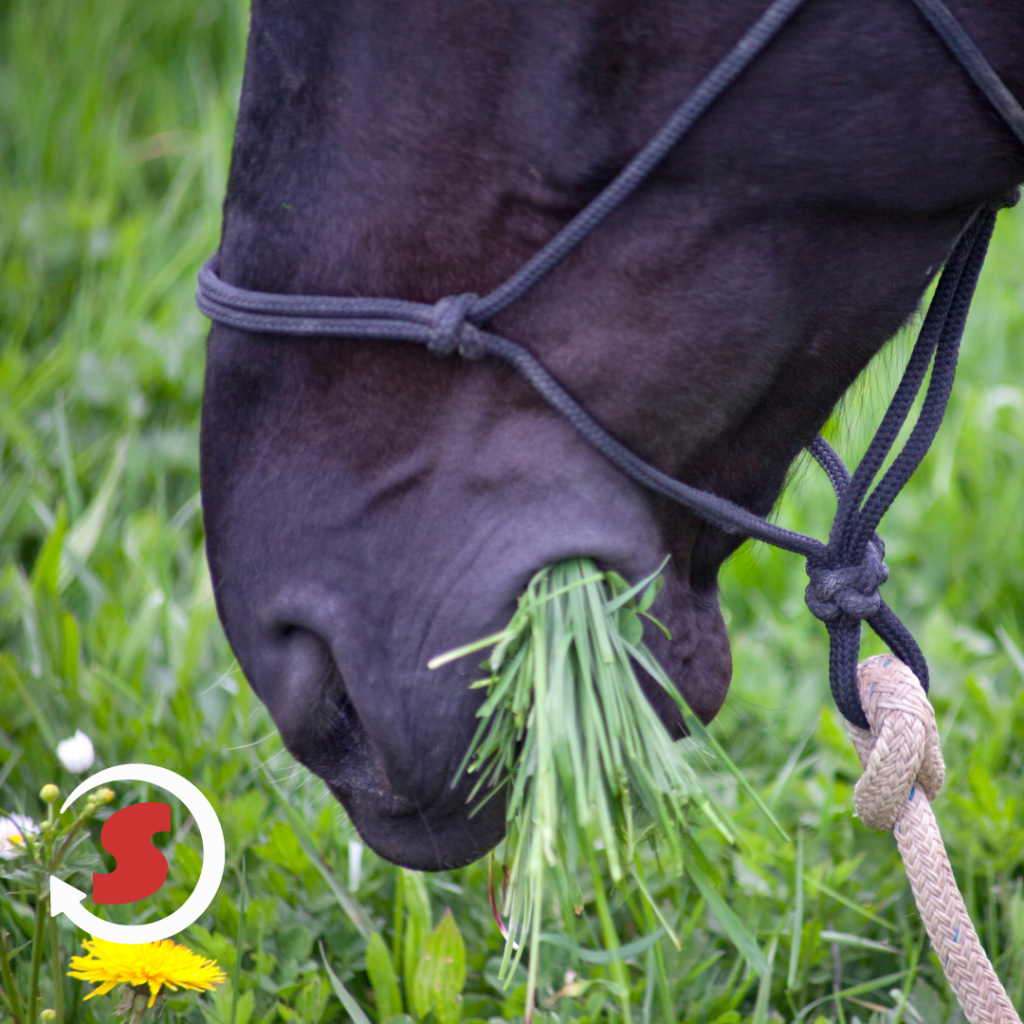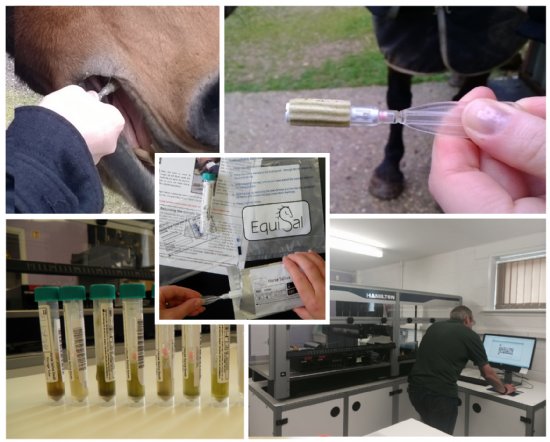It is Time to Tackle Tapeworm!
As we are heading into the Autumn months (apologies, we know it feels as though we missed Summer!) it is now time to start to look at our worming and testing for worms in our horses. At this time of year, and also Spring time, we look to test and/or treat for Tapeworm, this is due to this time of year being the season they are most active and reproduce more often.

So, what is Tapeworm?
Tapeworms have flattened bodies and are made up of segments called proglottids, which are full of eggs ready to be fertilised. Did you know? Each segment is capable of reproducing by themselves by having both male and female reproductive organs, which means the rate of infestation is self sufficient, making testing and treating imperative to routine horse care throughout the year.
Tapeworm attaches itself to the gut wall, using suckers, inside the intestines, where they then feast on food – meaning the nutritious feed you have lovingly prepared, is being consumed by these parasites! This can then lead to your horse struggling to absorb the nutrients from their food, resulting in symptoms such as loss of weight, and lethargy.

How would my horse contract a tapeworm infection?
The tapeworm lifecycle requires an intermediate host, which usually consists of a flea or oribatid mite. Horses that are already infected, pass tapeworm segments which are full of eggs onto pasture, they are then free to be consumed by these free-living intermediate hosts. Within the hosts’ digestive tract the eggs develop into larvae, this is where they begin to be able to live within the environment. The origin – the host – is then ingested by a horse when grazing, this is then killed within the horses digestive tract by the stomach acid, which allows the tapeworm larvae to be released into the horses intestine. The life cycle of larvae then complete their life cycle by attaching themselves to the lining of the intestines, allowing them to develop into adult tapeworms that are then capable of releasing their own egg filled segments.
As the tapeworm matures, the body is composed of maturing segments, in a chain. New segments are constantly being produced behind the tapeworms head as they develop progressively and grow/push towards the rear. The mature segments are full of fertilised eggs (also known as gravid) and ready themselves to then detach from the body of the tapeworm, where they then pass through, inside the faeces into the horses environment, they are then eaten by the oribatid mite – and so the cycle begins again.
It is for this reason, that if you believe your horse has never suffered from tapeworm in the past or has not been affected, continual testing and treatment is still necessary. The reason for this as mites can pass from pasture to pasture and from horse to horse. If you move your horse to a different yard, or a new horse moves to your yard, or if you take your horse to a competition or day out, there is always a possibility that your horse may have encountered a tape worm-infested oribatid mite – or simply another horse that has passed tapeworm segments in their droppings.
How often should I be testing for tapeworm?

The optimal times to test for tapeworm, are the Spring and Autumn months, so therefore you should be looking to test twice a year, ideally. This is due to the tapeworm being most active and reproduce more often.
Ensure you leave 4-6 months between your last test/treatment and your next tapeworm test. The reason for this timeframe is due to the tapeworm specific antibodies taking up to 6 months to dissipate within a sample for horses who have never been tested or rarely suffered from tapeworm. An example would be, you carry out a regular worming treatment and then test almost right away, results could come back that your horse is still infected with tapeworm when this may not be the case.
Another scenario to consider is if your horse has had a previous borderline or moderate/high diagnosis, you can retest 2-3 months after worming treatment for tapeworm. It has been shown that, in most cases, tapeworm specific antibodies reduce within a few weeks following treatment.
Austin Davis Biologics have conducted a study regarding this, which can be found below:
“Austin Davis Biologics (who produce EquiSal Saliva Tapeworm Tests) carried out a pilot trial in which EquiSal Tapeworm testing was carried out on horses (with access to grazing) every two weeks following deworming treatment for tapeworm. Data collected from this trial showed that, in most horses kept in well-managed paddocks, reduction in tapeworm-specific antibodies was seen within two to three weeks following treatment. 73% of horses had Saliva Scores which dropped to low within five weeks of treating for tapeworm. The remaining horses took a further six weeks to drop to low. This suggests that antibodies present in saliva have less memory of tapeworm infection than antibodies in blood, however, it is still recommended to leave the ideal 4-6 months before testing. This is especially true for horse’s who regularly leave the yard, are grazed with a variety of different horses year-round, and those who are kept on poorly managed land.
It is important to understand that horses can still become reinfected by tapeworm larvae after any worming treatment. Tapeworm reinfection has been seen in horses kept in poorly managed paddocks where reinfection can happen very easily. Nonetheless, given the necessity for an intermediate host in the tapeworm’s life cycle, even well managed paddocks containing horses with high tapeworm burdens could harbour infected oribatid mites within the environment. This means that there is still a reinfection risk after worming for horses grazing in these circumstances.”
What do I use to test my horse for tapeworm?
Testing for tapeworm is essential, more so now than ever! This is to reduce the risk of resistance, which is becoming an ever growing concern for the equine community. If we were to worm, rather than test for worms, each time, the worms become resistant to the active ingredients used to treat them. Therefore, the active ingredients within your wormer, become less effective and will have a knock on effect for each treatment in the future.
The EquiSal Saliva Tapeworm Test Kit is highly effective way of testing your horse for tapeworm. You will receive within your kit, a swab that is immersed in preservative with a testing tube, a barcode sticker to identify your horses sample and a pre-paid returns envelope.
To carry out the test, follow the below steps:
- Allow your horse to stand without eating or being exercised for at least 30 minutes before conducting the test.
- Remove the swab from the tube, place this within the corner of the horses mouth and hold it there for 30 seconds, this allows the swab to collect enough saliva for an accurate test and result to be given.
- Take the swab and place within the tube filled with preservative and then seal the tube as best you can.
- Place this inside your provided return envelope, and send your sample off!

It is important to note, try to ensure the sample is sent on the day you collect from your horses mouth, and try to do this at the beginning of the week, where possible, to ensure the sample remains viable when arriving at the lab for testing.
The tests will be carried out, and then reported to you, during which you will be advised if your horse requires treatment or not, and which course of action is next best to take.
I've been told my horse needs treating, what should I do next?
So you may be told your horse requires treatment for tapeworm, do not panic! Whether a borderline or moderate/high diagnosis (or if it is appropriate due to time of year) it is best to use a wormer containing Praziquantel or a double dose of Pyrantel Embonate.
Try to ensure you weigh your horse as accurately as you can, so you can be sure the appropriate amount of wormer is administered to your horse. The best view to take is to slightly overtreat your horse to ensure that all worm burdens are treated accordingly.
A good example is:
Your horse has weighed in at 430kg, treat up to 450kg.
NEVER give your horse more wormer than is necessary.
A bad example is:
Your horse weighs 430kg, giving your horse more than 500kg worth of treatment will increase the risk of wormer resistance to the active ingredients. Which will eventually reduce effectiveness of your worming treatments, causing worm burdens more difficult to treat in the future.
Overall, testing as a first point of action is always best to ensure that deworming strategies are effective and current data from EquiSal testing suggests that regular testing has an important part to play in monitoring effective worm control.




![EquiSal Saliva Tapeworm Test [Worm Count Kit] (Equine) EquiSal Saliva Tapeworm Test [Worm Count Kit] (Equine)](https://www.supplementsolutions.co.uk/media/amasty/amlabel/1bulkbuynew.png)

